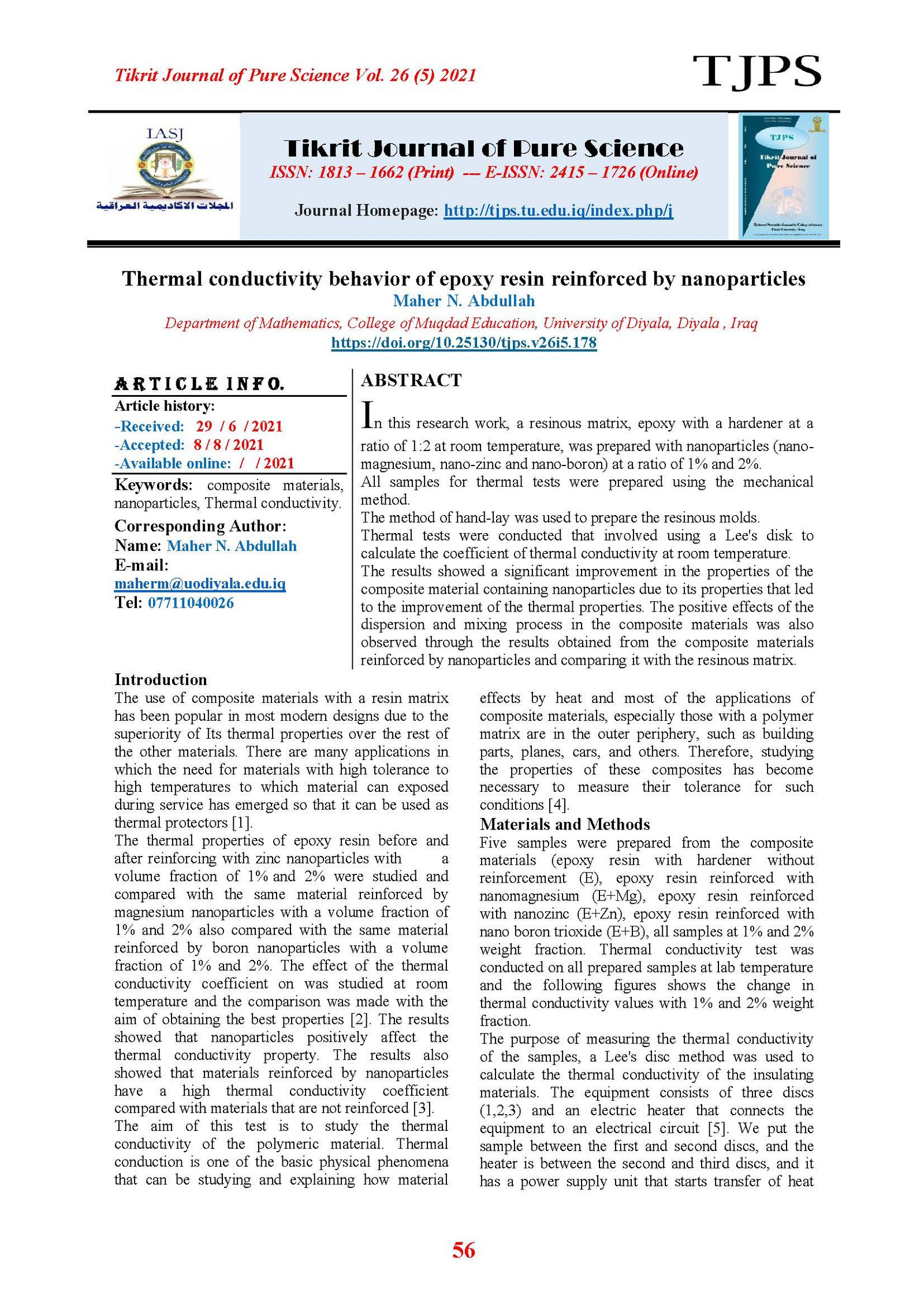Thermal conductivity behavior of epoxy resin reinforced by nanoparticles
Main Article Content
Abstract
In this research work, a resinous matrix, epoxy with a hardener at a ratio of 1:2 at room temperature, was prepared with nanoparticles (nano-magnesium, nano-zinc and nano-boron) at a ratio of 1% and 2%.
All samples for thermal tests were prepared using the mechanical method.
The method of hand-lay was used to prepare the resinous molds.
Thermal tests were conducted that involved using a Lee's disk to calculate the coefficient of thermal conductivity at room temperature.
The results showed a significant improvement in the properties of the composite material containing nanoparticles due to its properties that led to the improvement of the thermal properties. The positive effects of the dispersion and mixing process in the composite materials was also observed through the results obtained from the composite materials reinforced by nanoparticles and comparing it with the resinous matrix
Article Details

This work is licensed under a Creative Commons Attribution 4.0 International License.
Tikrit Journal of Pure Science is licensed under the Creative Commons Attribution 4.0 International License, which allows users to copy, create extracts, abstracts, and new works from the article, alter and revise the article, and make commercial use of the article (including reuse and/or resale of the article by commercial entities), provided the user gives appropriate credit (with a link to the formal publication through the relevant DOI), provides a link to the license, indicates if changes were made, and the licensor is not represented as endorsing the use made of the work. The authors hold the copyright for their published work on the Tikrit J. Pure Sci. website, while Tikrit J. Pure Sci. is responsible for appreciate citation of their work, which is released under CC-BY-4.0, enabling the unrestricted use, distribution, and reproduction of an article in any medium, provided that the original work is properly cited.
References
[1] Kochetov, R. (2012). Thermal and Electrical
Properties of Nanocomposites, Including Material
Processing. Ph.D. dissertation: 197 pp.
[2] Devendra, K. and Rangaswamy, T. (2012).
Evaluation of Thermal Properties of E-Glass, Epoxy
Composites Filled by Different Filler Materials.
International Journal of Computational Engineering
Research, 2 (1):1708–1714.
[3] Wereszczak, A. A. et al. (2013). Thermally
Conductive Mg-Filled Epoxy Molding Compounds.
IEEE Trans. Components, Packag. Manuf. Technol,
3(12):1994–2005.
[4] Sirdeshmukh, D. B. et al. (2006). Thermal,
Mechanical and Dielectric Properties. Hull, R and
Osgood, R. M.(eds), Micro- and Macro-Properties of
Solids. Springer-Verlag Berlin Heidelberg:37-71.
[5] Agrawal, A. and Satapathy, A. (2019). Thermal,
Mechanical and Dielectric Properties of Aluminum
Oxide and Solid Glass Microsphere‐Reinforced
Epoxy Composite for Electronic Packaging
Application, Wiley Online Library, 40 (7):2573-
2581.
[6] Godovsky, Y.K. (1992). Thermo - physical
Properties of Polymers. Witold B. (eds), Mechanical
and Thermophysical Properties of Polymer Liquid
Crystals Springer-Verlag: 127-162.
[7] Yang, Y. (2007). Thermal conductivity. Mark J.E
(eds), Physical properties of polymers. Handbook.
Springer: 155-163.
[8] Tekce, H.S. et al. (2007). Effect of Particle Shape
on Thermal Conductivity of Copper.
[9] Hansen, D. and Bernier,G. A. (1972). Thermal
Conductivity of Polyethylene: The Effect of Crystal
Size, Density and Orientation on the Thermal
Conductivity. Polymer Engineering and Science.
12(3):204-208.
